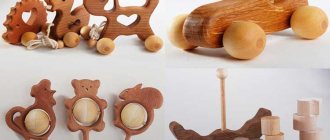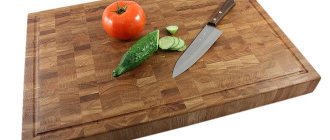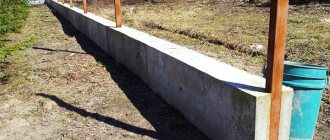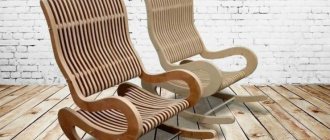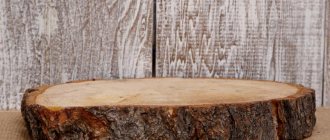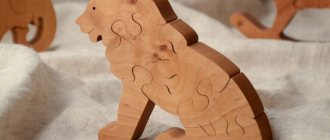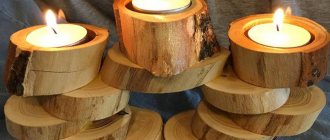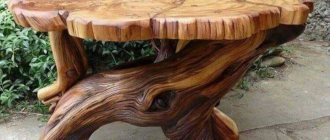A simple wema, assembled “on the knee”
Sometimes there are situations when some type of work needs to be done once.
Suppose it is decided to arrange a table made of laminated spruce in the gazebo at the dacha. Does it make sense to buy expensive factory-made clamps? In such cases, a simple, in a sense disposable, wedge is made with your own hands. Drawings of the device are shown below. In order to glue an array of blanks together once, you will need long self-tapping screws, a screwdriver, a hacksaw and a carpenter’s hatchet.
The blanks are laid on a series of transverse beams (beams every 40...45 cm). On both sides of the workpiece, parallel to it, long longitudinal beams (equal in height to the workpiece) are laid and attached to the crossbars with self-tapping screws. On top, again, the upper transverse bars are fastened with self-tapping screws. That's all the vayma, made with your own hands.
To compress the workpiece, all that remains is, as shown in the diagram, to wedge it with specially planed wooden wedges. After the product is ready, the clamp can be disassembled and the material can be used at your discretion.
Crimping grip
Band crimp clamps (crimp clamps, O-clamps) are rarely used by home craftsmen. But it’s not a technological circumstance that makes me remember them: 3,000 rubles. For a branded one it's still cheap. Meanwhile, an O-clamp that is no worse can be made with your own hands.
For this you will first need a flat textile sling and 4 swivels for it. The corner clamp, jaw and screw clamp slide are made of wood and fiberboard, on the left in Fig. The procedure for use has some peculiarities (by the way, the same applies to the most expensive branded ones).
Homemade crimping clamp for furniture and carpentry work
Let's say we need to assemble a series of identical photo frames. If they are different, the tool will have to be retooled for each. If not, then:
- The product parts are initially assembled dry, without glue.
- Lay it out on a plaz (flat plane) and use the marks on it to set 90 degree angles.
- Loop the slings and place the clamps in the corners.
- By moving the swivels, we achieve a weak, uniform tension on the branches of the sling (on the right in the figure).
- Gradually tighten the clamp, watching the corners of the product.
- If one of the corners diverges, then you need to apply a little sling in its direction, pulling it through the sotv. swivels.
- The adjustment of the crimping clamp is considered complete if it is possible to use a clamp to bring all the corner gaps “into a thread” - there is no need to turn the screw any more.
Now, if a series of products is being made, after gluing one screw, the screw is loosened, the next one is inserted (with glue in the corners), the clamp is tightened “to the threads,” etc.
Technology for the production of laminated wood panels
Even if the material (log thickness) allows for the production of wide products, their further use raises a number of questions. Things made from solid wood are very difficult to use. Those who have worked extensively with wood know very well what a “propeller board” is.
In order for a solid wood product not to deform, the material must first be thoroughly dried and, preferably, kept for at least a month in the room where it will be located. This condition is practically impossible to fulfill when we are dealing with a door leaf or window sill - humidity and temperature changes will inevitably lead to deformation of the product.
Elements made from laminated wood do not have these disadvantages. Bars are taken from the same or different ones, assembled into a single block and glued. In order for the wooden blanks to become a single whole, a special device is used - a clamp. You can easily assemble a fully functional device with your own hands.
Why are glued wood panels made?
Do-it-yourself wigwam: varieties of materials, step-by-step instructions for making, arranging and decorating with your own hands
Even if the thickness makes it possible to create products with a large width, their subsequent operation raises serious doubts. Those who often deal with wood know very well that solid wood products are quite capricious in terms of use.
To ensure that a wooden product does not lose its original shape, the wood itself must be dried very well in advance. It is advisable to keep the material for at least four weeks in the conditions of the room where the product will be located subsequently. However, this condition is very difficult to comply with when it comes to a window sill or door. Changes in temperature and humidity, one way or another, will lead to deformation.
Gluing helps get rid of this drawback. To do this, wooden blocks are folded into a complete panel and then glued. In order for the workpiece to truly turn into a single whole, a special mechanism is used - a clamp. It can be created quite simply at home, saving a lot on factory models.
Steel profile wedge
But sometimes craftsmen assemble wires no worse than factory ones. Here's one option:
The clamping screw is first unscrewed until it stops. The slats are glued and placed on the clamp, starting from the clamping unit. After the array blank is assembled, it is covered with an upper profile pipe, and a mating unit is bolted into one of the pairs of holes (depending on the width of the future array).
By rotating the clamping bolt, the workpiece is compressed from the sides. The design of the clamp is made in such a way that the upper and lower pipes are also strongly pressed against each other when the screw is tightened, which makes the future workpiece perfectly flat. This kind of webbing, made with your own hands, allows you to make any product - from cutting boards to door panels.
Wooden fixtures never lose their relevance and never go out of fashion. They are highly environmentally friendly, natural, and can be used to construct almost any piece of furniture. They serve for a long time and lend themselves well to restoration. You can make stools, doors, steps from wood with your own hands. For production, the craftsman needs numerous tools that allow him to work with the material. These are carpentry weims. They are familiar to everyone, but their size is much larger.
How to glue wooden boards into a board
To properly glue furniture boards
, first you need to acquire special equipment:
- Planing machine;
- Circular Saw;
- Hammer;
- Thicknesser for drawing marking lines;
- Long ruler, tape measure and pencil;
- Clamps or homemade tools for tightening boards;
- Surface and belt sanders for stripping wood. Instead, you can use sandpaper, screwing the wood onto the block, but cleaning will take more time;
- Electric planer;
- Wooden boards.
- Glue.
To successfully glue boards, it is important to choose high-quality and reliable glue:
- Isofix G818. Professional wood glue made on the basis of polyvinyl acetate. It does not contain solvents, is characterized by high moisture resistance and powerful fixation, used for interior and exterior work, gluing any type of wood. Becomes transparent after drying. Product cost: 232 rubles per 500 ml package.
- Joiner or Super PVA Moment. Heat-resistant, quick-setting and high-strength adhesive designed for gluing all types of wood, chipboard, MTF, DVM, veneer, plywood, fittings and laminate. After drying it becomes transparent. Cost: 330 rubles per 750 ml package.
Instructions - how to glue a shield without clamps and clamps
Once you have all the equipment, tools and suitable glue ready, start gluing the shield. This process consists of several stages.
Preparing the boards
The wood for making shields must be of the same type.
Types of wood that are used to make furniture panels:
- Birch;
- Pine;
- Clear;
- Larch;
- Aspen.
The wood must be dry, smooth and free of knots. It is best to buy ready-made timber and cut it at right angles into pieces of the required size. If there are any unevenness on the bars, use a planer.
The thickness of the boards should be several millimeters greater than the final parameters of the shield, since after gluing and drying they will need to be refined by sanding. To do this, select a workpiece with a width to thickness ratio of 3:1. The boards should be no wider than 15 centimeters so that excessive stress does not arise in them during drying.
Preparation for gluing
Before connecting all the boards, they must first be adjusted so that you get a beautiful shield:
- Build a flat surface so that it is convenient to glue the board from the boards. For this, it is best to use a chipboard sheet;
- Attach the strips to the two edges of the chipboard, adjust their height in accordance with the height of the workpieces;
- Place the boards between the planks so that they fit snugly together. If there are gaps, remove them with a jointer. Carefully examine the wood grain of each specimen. The lines of adjacent blanks should connect smoothly and then the shield will turn out beautiful. To adjust the lines, move the boards along the length;
- After placing the blanks on the chipboard sheet, mark them or mark them with figures so that you can quickly put the board back together.
Gluing process
Once you have adjusted the boards, glue them together one by one.
- Cover the surface to be glued completely with glue. It is important not to apply too much glue, otherwise it will cover the seams. But do not neglect the glue - its deficiency will negatively affect the strength of the shield;
- Press the greased boards firmly one to the other;
- Attach two more planks perpendicularly to the two planks located on both sides of the chipboard and secure them with self-tapping screws. This will avoid bending of the furniture board when gluing;
- To increase the adhesion of the bars, use wedges. Press the boards until the first drops of glue appear on their surface;
- Let the shield dry for about an hour. Then remove it from the surface of the chipboard sheet. Do not touch the material for another day.
VIDEO INSTRUCTION
Final stage
As soon as the homemade furniture board dries, the wood must be sanded, planed and traces of glue removed.
This will give you a smooth and even surface:
- Place coarse sandpaper in the sander to pre-sand;
- Then treat the surface of the shield with a surface grinder;
- If you notice lint, you can get rid of it with a small amount of water. Pour it onto the surface of the furniture board and wait until it dries. After this, the fluff will rise and can be easily removed with sanding equipment.
By following these instructions, you will create a high-quality furniture board that will become an excellent basis for the construction of bedside tables, tables, shelves and many other items for your home.
Currently, the industry offers clamps or clamps of various designs. But they are too large in size and expensive. Therefore, you can make a clamp yourself for your home carpentry workshop.
Using a homemade wedge, you can perform gluing furniture panels and other carpentry work.
What materials will be needed
To build a homemade clamp, you first need to collect the necessary materials and tools. To work you will need:
- profile pipe, metal corner or channel;
- fastening elements: nuts, screws, self-tapping screws;
- stops;
- building level and squares;
- Bulgarian;
- metal welding machine;
- wooden spacers.
Do-it-yourself carpentry clamps must be strong and strong, otherwise, with great effort, you can bend or break the structure. To prevent this from happening, the stops must be resistant to heavy loads and be well fixed to the beam. It is necessary to make sure that they can easily move in the longitudinal direction. To be able to process large workpieces with your own hands, you need to fix the clamps on the clamps so that they can be moved.
Fastening elements must also have high strength. It is better to give preference to reinforced construction and nuts. Due to the high load, store materials quickly break down. In order for the carpentry clamps designed by yourself to be of high quality and effective, you should order fasteners and stops from a turning workshop.
Better quality fasteners and stops can be made using a lathe or ordered from a factory
Instructions for performing the work
All work on producing a rim with your own hands involves several stages:
Clamp assembly diagram
- Preparing a profile pipe. Its length is 1.2 m.
- Assembly of bolted structures. It will be convenient to weld the clamp elements together. For assembly on corners whose length is 250 cm, a channel is attached at the same distance.
- The edge of 1 channel and the short corner should be perpendicular to each other, and located between the long fragments. Under the nuts it is necessary to place spacers, the thickness of which is 1 cm.
- Processing of joints by welding. The internal joint between the short angle and the channel is not processed. If this condition is not met, the seam resulting from welding will create problems when gluing wooden workpieces.
- Making clamps from a metal rod. Its diameter is 5 cm. A 1 cm hole is drilled at the end of the screw. 2 ball bearings are installed inside it to reduce friction.
- Welding the nut. The screw must be parallel to the profile. If this rule is not followed, the part will be clamped with pushing.
- Making clamps from the corner and securing them. For fixation, holes are drilled in the material, the diameter of which is 1.2 cm. Pins are inserted here, allowing you to change the position of the workpiece during the manufacture of a wooden product.
Stops are welded to the bottom of the resulting structure, thanks to which it will be stable. When making the wedge with your own hands, you need to ensure that all the parts are parallel. A building level is used for this. Welding seams should be small
In the process of fastening parts, it is important to ensure that the metal does not deform during heating.
Machine tools
As stated above, it is most profitable to make a machine vice with your own hands. They greatly simplify drilling work, and the material for the machine vice is suitable for almost any available material: from a channel, see video:
to plywood, see story:
And again sponges
The strength and stability of the jaws for a machine vice is even more important than for a bench vice: if a drill (cone, cutter) turns a part out of them, this can lead to serious injury. And so, we return to the question above: what are the vice jaws made of? From a corner from 40x40x4. In this case, the entire sponge will work not for shear, but for bending, to which the metal resists much more strongly. This is the case when less iron turns out to be stronger.
But not every corner of the same size is suitable. A drawn and cold-rolled corner (pos. A and B in the figure below) is unsuitable - the metal is rather weak. The jaws of both homemade and metalworking and machine vices must be made from hot-rolled angle (pos. B). Firstly, it is much stronger. Secondly, the range of its standard sizes is wider: if the thickness of the flange of a cold-rolled general-purpose angle is up to 0.1 of the width of the smaller one, then for a hot-rolled angle it is up to 0.2b. That is, you can find a hot-rolled angle, say, 60x60x12 - the vise jaws from it will be quite reliable.
Types of steel angle
A hot-rolled angle is easy to recognize by the type of cut: the entire edge of the outer corner is always sharp (shown by the arrow on the left in the next figure), and inside it there is a fillet larger than that of a cold-rolled angle. If the vice is assembled by welding, both equal and unequal angle angles will do. If you assemble them with bolts, it is better to use an unequal shelf with a shelf width ratio of (1.5-2)/1 (a/b = 1.5...2/1). In this case, the large shelf is laid horizontally!
Angle steel machine vice
The design diagram of a homemade machine vice from a corner with bolts is given in the center in Fig. on the right are drawings of their general appearance. The slider and bracket for the clamping screw are bent from a steel strip with a thickness of 1.5 mm. The screw in it can be fixed with a groove, because its fixation works only when the movable jaw is retracted and is loaded negligibly. On the clamp, the tail of the screw rests directly on the sponge; the screw itself is M16-M20. For more information about homemade machine vices from a corner, see the video:
Clamps for gluing panels: stages of work
We make markings on the profile pipes and drill through holes every 15 cm, using a regular or stepped drill. We cut the steel strip with a grinder into pieces 150 mm long. In these plates we drill two holes of the required diameter.
We connect the profile pipes to each other using plates. You will also need stops - a movable square one and a fixed T-shaped one, welded from a profile with side dimensions of 20x20 mm. We screw a pin of suitable length into the movable clamp.
G-shaped
The frames of factory-produced G-clamps are cast. It is impossible to organize a steel foundry in a garage or barn, even in a forge on your own property. Since G-clamps, being the most “graspy” ones, are used mainly in metalworking and welding work with rather long and/or heavy parts, a homemade G-shaped clamp must be made of welded or solid metal.
Craftsmen often weld themselves clamps from sheet steel, pos. 1 in Fig.:
Homemade G-Clamps
Apparently, copying the profile of the frames of factory products, which in this case is incorrect. Profiles of cast frames of clamps are shown in pos. 2
Pay attention to the fairings and fillets (shown by arrows). Smoothing the profile is necessary to avoid the concentration of mechanical stress: they “love” corners and crevices, like bed bugs
But the weld does not work like a fillet! No, the clamp most likely will not break or bend. However, the recoil of the clamped part will move the frame a little, and it will be difficult to achieve precise fixation, and it is possible that the part may rotate when the clamp is tightened.
Homemade clamps made from channel sections are quite reliable (item 3). Disadvantages: labor-intensive, disproportionately heavy compared to the working width. You can cut a channel into clamp frames if you need to compress the parts very tightly. The best option for clamp frames for normal work is made from a square profile pipe, pos. 4. Depending on the size and wall thickness of the workpiece, clamps from corrugated pipe can be made for a working width of up to 1 m or more, see video:
https://youtube.com/watch?v=8R1fXWCJTds
G.E.
A type of G-clamp is a clamping one, which could roughly be called a GE-clamp. Clamps are well known to builders of small wooden boats, but they will also be very useful in small wooden construction (for example, a country or frame house, outbuilding, etc.).
Drawings of the clamping clamp and the method of their use are shown in the figure:
Drawings and procedure for using clamping clamps
For example, when sewing, say, a crossbar (truss structure) of a roof, each subsequent board is first pressed tightly against the previous one, and then attached to the rafter beams. Accordingly, the reliability and durability of the entire roofing pie are greatly increased.
F-clamps
Design Features
. The clamp consists of a guide rail on which movable and fixed jaws are fixed. The movable clamp, sliding along the guide, has a set screw that allows you to adjust the desired grip length and prevents the clamp from loosening. The jaws are equipped with pads to protect the fixed surfaces.
Advantages
. The main advantage of F-shaped clamps is their versatility. The adjustable grip length makes it possible to firmly and firmly fix workpieces of various thicknesses.
Flaws
. It is not always convenient to work with an F-shaped clamp, because... To manipulate the tool you have to use both hands.
Application area.
Used for fixing wooden products and workpieces of various thicknesses.
Classification of shield wires
The capabilities of the installations are determined by the power of the power unit, the dimensions of the material being processed and the presence of functions that allow you to set the most efficient operating mode when using raw materials with specific characteristics. Each type of product corresponds to a device with design features. Weights for gluing furniture panels are divided into 3 categories according to the type of load created:
- hydraulic;
- pneumatic;
- rotary.
The machines are available in horizontal and vertical versions, have different numbers of working sections and differ in pressing force. Devices with a vertical layout occupy a small area and are the best option for rooms with cramped conditions. Equipment with a hydraulic system is characterized by increased power and the ability to produce smooth and uniform pressure on the surface of the batch workpiece.
Operating principle of the installations
Weights for furniture panels have a fairly simple design, including units for basing, fixing and pressing a package of blanks.
Stops are fixed to a stable metal frame, which serve to prevent distortions when laying the package and are made in the form of stably fixed and movable rulers. The ability to quickly change the position of the basing elements ensures rapid reconfiguration of operating parameters when working with workpieces of different sizes. The force of hydraulic or pneumatic equipment drives the clamping elements, with the help of which the structure is assembled. The technological strength of the connection is achieved due to the force applied to the parts and the exact period of holding the package during pressing. In devices with heating elements, processing time is reduced due to the thermal effect on the workpiece, which accelerates the polymerization process of the adhesive. Changing the pressure parameters in the system is done from the control panel.
Why do we need joiner's wires?
Making wooden products with your own hands is not an easy job, requiring high precision work and the ability to work with tools. Do-it-yourself carpentry clamps should not be called a press, since they are not equipped with a mechanism for drying the glue. They are a large and powerful clamp.
The design of the clamp is made in such a way that the upper and lower pipes are also strongly pressed against each other when the screw is tightened, which makes the future workpiece ideal
Joiner's weims are used for the following cases:
- gluing parts with an unusual shape;
- fixing facing edges;
- assemblies of puff and furniture panels, timber;
- designing frames, frames of furniture, chairs;
- cladding of relief, flat and volumetric surfaces;
- wood splicing;
- assembly of frame products (windows, doors);
- production of steps, stairs.
Using Vime
In order for a wooden product to have a beautiful appearance, proper quality and meet its purpose, in the process of working on its manufacture it is necessary to strictly comply with all requirements. When connecting parts of a wooden structure, efforts are required so that there are no cracks or gaps at the joints and that they are positioned in relation to each other perfectly accurately when gluing.
Each master can make clamp clamps with his own hands, which will be useful to him in the workshop. With their help, you can make connections between parts of unusual, unique shapes, cover flat, volumetric and relief surfaces, design framed facades, stair steps, assemble furniture, panels, etc. with your own hands. They also splice wood and fix edges for cladding.
To glue or join bars in thickness and width, horizontal or vertical wedges are used, which can be single-story or multi-story. Fan and rotary types of weims are also used. Other varieties are used to assemble various frame furniture structures from bars, door and window blocks, including with your own hands.
Sometimes the work of professional craftsmen requires the use of stops and hydraulic cylinders. For these cases, single-sided or double-sided clamps, or devices with rotors with a horizontal axis of rotation can be used.
How to make disposable wedges from timber
This is a simple design option. It is not the most reliable, but sometimes it happens that for constant use it is not needed. This instruction will allow you to create a simple disposable clamp.
You will need:
- beam;
- high strength self-tapping screws;
- saw;
- carpenter's hatchet;
- screwdriver
The creation technology is as follows:
- Wooden parts must be laid flat and horizontal.
- Position the workpiece. The gap between the parts is approximately 40 centimeters.
- On both sides of the workpiece, strictly parallel, it is necessary to lay a long beam, which is attached to the crossbars with self-tapping screws.
- To compress the workpiece, the clamp must be wedged with special wedges.
- As soon as the wooden shield is glued, the wedge can be disassembled and the parts can be used for other purposes.
Hand-made frames are perfect for creating frames or, for example, simple furniture - for example, a small bed.
Features of making a simple wedge from self-tapping screws and timber
Sometimes a craftsman needs a large clamp to make one product. This does not require a permanent structure. You can make disposable weims with your own hands. To make the tool you will need:
- wooden beam;
- durable long self-tapping screws;
- jigsaw or hacksaw;
- screwdriver;
- carpenter's axe.
To properly build a structure, you first need to make a drawing of it. The technology for making a simple wedge is as follows:
- wooden elements are laid horizontally on a flat surface;
- place the workpiece. The distance between elements is 40 cm;
- on both sides of it, a long beam is placed strictly parallel, fixed to the crossbars using self-tapping screws;
- to compress the workpiece, the clamp is wedged with special wedges;
- As soon as the product sticks together, the clamp should be disassembled. Its elements can be further used for different purposes.
Do-it-yourself carpentry clamps are an excellent tool for making doors, steps, and window frames. Even if a person does not produce furniture, he can significantly reduce the cost of renovating his home.
In this article you will find detailed instructions for making weima
with your own hands.
If you are engaged in the manufacture of furniture from, then you cannot do without carpentry clamps
.
You don't have to buy it for this. You can make the glue for gluing with your own hands
.
Making a clamp with your own hands
The basis of the design of a homemade clamp is a strong load-bearing beam. It is made from a profile pipe of rectangular or square cross-section. The beam can also be made from a metal profile: an angle or a T-bar.
The supporting beam must have high strength and resistance to bending loads. This is necessary so that during operation the structure of the clamp does not bend or deform.
To compress the furniture panel you need to apply a lot of force. Therefore, if the load-bearing beams do not have sufficient strength, they will bend along with the workpiece.
If the furniture board that will be made on the frame must be large in size, then, accordingly, the most durable material for the base must be selected. In the wedge design, all stops and screws are located above the supporting beam. Therefore, the higher the stops and screws are, the stronger the bending loads acting on the entire structure will be. To do this, the clamp must have a very strong base.
When the clamp is working, a lot of pressure will be applied to all the stops. Therefore, the stops must be designed for heavy loads. Otherwise they may bend.
Lathe device
It is impossible to make a lathe with your own hands without knowing its structure, so below we present its main parts:
- Drive unit. The basis of the mechanism generates power. For a low-power machine, a drive from a drill or washing machine is suitable;
- Bed. A steel corner or a wooden frame is suitable for manufacturing; this is a kind of load-bearing frame, so it must be strong to withstand vibrations;
- Tailstock. It is made by welding a corner to an iron plate. It is needed for fixation during processing of the manufactured device;
- Headstock. Installed on a movable frame, similar to a tailstock;
- Caliper. Acts as a support for the working part.
The rotational torque is transmitted by the engine to the working part using the following options:
- Chain;
- With a belt;
- Friction.
The chain one is more expensive, it is more bulky, but it lasts a long time. In terms of its advantages and disadvantages, the friction one occupies a middle position. It is worth noting the fact that photos of a lathe with different gears are available on the Internet, and you can easily study them in detail.
The support is an extremely important part of the machine. It regulates both the amount of effort expended during work and the quality of the part.
DIY making
There is no need to purchase such equipment in retail establishments. It is not difficult to make a mechanical wedge with your own hands. Before starting work, it is recommended to first make a drawing. You can sketch it yourself, or find it on special websites. There you can also get acquainted with the detailed manufacturing technology of the structure.
Necessary materials
To construct weims with your own hands, a special load-bearing beam is used as a base. It must certainly be highly durable. In addition, you will need a profile pipe; you can use a rectangular or square one. It is also possible to use a metal corner or channel as a basis. This, of course, will make the structure heavier, but will give it additional strength. Such a clamp can also be made of wood, but the gluing of parts on it will not be sufficiently reliable and of high quality. Therefore, it is preferable to assemble this structure from metal parts.
As for materials and equipment for such work, you will need the following.
- Profile pipe.
- Channel or metal corner.
- Fastening elements.
- Wooden spacers.
- Square.
- Level.
- Welding machine.
As a result, the finished structure, made by hand, should be durable and withstand serious loads. Otherwise, the product may become deformed or even break during operation. It is advisable that the clamps be secured in such a way that they can move freely. This will allow you to use a home-made clamp, even for fairly large parts.
Step-by-step instruction
First of all, you need to make a base. Profiled pipes are used for this. They must be at least 1 m long. Sometimes it may be necessary to use a pipe bender. Then the parts are assembled using bolts. They need to be connected by welding. In cases where the assembly is carried out on metal corners, the channel must be fixed, and the spaces between them must be equal.
The short corner together with the edge of the channel are installed perpendicularly between the long parts. It would be a good idea to place shims about 10mm thick under the nuts. After this, connections are processed. For this purpose, a welding machine is required. Only the joint between the corner and the channel should be left untreated, otherwise a seam will appear that will interfere with gluing.
For clamps, you can use ordinary metal rods. Their diameter should be approximately 5 cm. Holes (1 cm) must be drilled in the end. Then insert ball bearings into them. This is done to reduce friction, which will extend the life of the structure.
Holes are also drilled to secure the clamps. Their diameter should be 10 mm. Pins are inserted into them. They will make it possible to change the position of the wooden element during processing. For additional stability and strength, it is recommended to weld special stops to the structure from below.
In the process of creating a carpentry frame with your own hands, you must strictly monitor the position of the parts. They must be installed exactly in parallel. A building level is used for clarification.
In addition, it is also important to ensure that there is no distortion of the metal during welding.
Stages of work execution
Start making a clamp with your own hands. It is necessary to prepare a profile pipe of rectangular cross-section with dimensions 60x30x3 mm. The length of the pipe should be 120 cm.
These dimensions for the load-bearing beam were chosen due to the fact that it is often necessary to glue large sheets of wood or make wooden doors. Therefore, the clamp must be of such dimensions that workpieces of such large dimensions can be secured in it.
Workpieces that are too large are rarely made. In most cases, furniture panels of small sizes and intermediate platforms for stairs will be produced. It is necessary to take measures in advance to ensure that when making the shield, glue does not get on the surface of the device.
In cases where the length of the clamp does not allow for a large workpiece, you need to glue such a shield in parts. First, workpieces of such width are glued together that they can be clamped in a clamp. Then a wide blank is assembled from narrow shields. For this purpose, movable clamps are used.
Then you need to make screws and nuts. The screw is made from a hexagon 300 mm long with a cross section of 28 mm. It must have a metric thread of 2 cm. The nut is made in the form of a 32 mm hexagon, 60 mm long.
Spacers 1 cm thick are placed under the nuts. Then welding is performed. After this, a clamp is made from a 5 cm metal rod.
It is not advisable to make a clamp with a smaller diameter. Otherwise, it will push through the wooden spacers that are placed between the workpiece and the clamp. If you do not use spacers, you can deform the workpiece.
You need to drill a 1 cm hole in the end of the screw on the clamp side. 2 ball bearings are installed in this hole to reduce friction.
Then the nuts are welded. It is necessary to ensure that the screw is parallel to the profile. Otherwise, the workpiece will be pressed through.
You need to completely tighten the screw and nut. Then a clamp is put on the groove. After this, gaskets are placed under it.
Using a level, make sure that the parts are positioned strictly parallel. The parts are secured and then welded.
Welding is performed with small seams to prevent deformation of the material when the metal is heated during welding.
Then clamps are made from a corner measuring 60x60 mm. Weld the corner to the profile. The profile is welded from two corners. They are adjusted so that there is the possibility of free movement and at the same time so that there are no large gaps.
Fasten the clamps. To do this, drill holes with a diameter of 12 mm. They put pins in them. Thanks to this, you can quickly change the position of furniture parts during production.
If during work the workpiece turns out during compression, then the reason for this may be the non-perpendicular position of the stop in relation to the supporting beam. Therefore, you need to check the correct location of the parts using squares and a building level.
Then a hole is drilled, a thread is made and a screw is screwed in. The correct position of the workpiece can be adjusted using a screw.
When drilling holes, take into account that the screw with a movable stop moves 200 mm. When attaching a fixed stop, the distance between the holes should be 150 mm. Otherwise, areas may appear where the workpiece will not fit.
First, a through hole is made on the clamp. After that, install it in its place and press it with a clamp. Then the profile of the supporting beam is drilled through this hole. This way you can accurately fasten parts together.
You can make a clamp in which you can press the shield to the supporting profile. This design is more reliable, but more difficult to manufacture.
This concludes the work on making a homemade clamp.
The design of the clamp allows for high-quality gluing of furniture panels of various sizes and thicknesses.
On the website Stankoff.RU you can buy clamps for gluing furniture panels from leading manufacturers. There are more than 13 models of shield wires in stock and on order at the best prices. Only profitable offers with detailed descriptions and photos. Check prices with managers.
What materials will be needed
To build a homemade clamp, you first need to collect the necessary materials and tools. To work you will need:
- profile pipe, metal corner or channel;
- fastening elements: nuts, screws, self-tapping screws;
- stops;
- building level and squares;
- Bulgarian;
- metal welding machine;
- wooden spacers.
Do-it-yourself carpentry clamps must be strong and strong, otherwise, with great effort, you can bend or break the structure. To prevent this from happening, the stops must be resistant to heavy loads and be well fixed to the beam. It is necessary to make sure that they can easily move in the longitudinal direction. To be able to process large workpieces with your own hands, you need to fix the clamps on the clamps so that they can be moved.
Fastening elements must also have high strength. It is better to give preference to reinforced construction and nuts. Due to the high load, store materials quickly break down. In order for the carpentry clamps designed by yourself to be of high quality and effective, you should order fasteners and stops from a turning workshop.
Better quality fasteners and stops can be made using a lathe or ordered from a factory
Shelves for tools and materials
Setting up a home workshop begins with installing practical shelves for tools with your own hands. They can be made of metal or wood, or have a combined design - a metal frame with shelves made of wood, plywood, chipboard, plastic, etc.
The following basic structures are distinguished:
- Racks in the form of a frame and shelves located at different heights.
- Shelves mounted on the wall. They can be installed on brackets or attached with dowels directly to the wall surface.
- Hanging shelves with ceiling mounting.
Recommendation. Shelf-boards are convenient and practical in the home workshop. They can be used to install small tools that can be viewed and easily removed.
Practical shelf-boards have this design. The basis is a shield cut from plywood 8-12 mm thick.
There are 3 types of fasteners mounted on it:
- a rail with slots for placing tools with a handle in a vertical position (hammer, screwdrivers, chisels, etc.);
- shelves with a side for placing boxes with small tools (drills, taps, dies, etc.);
- hooks for hanging small tools (knife, scissors, measuring tool, etc.).
This shelf-shield is fixed to the wall using dowels.
Selecting a unit with optimal characteristics
Modern devices for assembling wooden structures using the compression method are available in a wide range of varieties, the purpose of which is determined by the type of product being created. In the serial production of frame and panel products, it is possible to buy wedges for panels, special devices for durable gluing of material using side pressure.
Machines for adhesive assembly of parts under pressure are a necessary type of equipment in enterprises producing furniture facades, entrance and window groups. Uniform distribution of pressure along the plane of the package makes it possible to produce products with high performance and decorative characteristics. The main purpose of the clamp for gluing panels is to create clamping force with an optimal level of pressure, which ensures:
- no gap between joined elements;
- extremely precise position of the parts to be connected;
- clear geometric parameters of a given shape;
- dense and durable joining of elements.
Compact installations do not require a special base, occupy a minimum area in production premises, are economical to use and have simple maintenance. Productive and reliable machines guarantee the production of products in full compliance with the technical requirements for laminated laminated wood.
When choosing a clamp for gluing timber or manufacturing panel structures, you should take into account the technical characteristics of the installation, which affect the functionality and performance of the device:
- dimensions of products proposed for production;
- number of installed hydraulic cylinders or pneumatic chambers;
- indicators of the total pressure on the surface of the workpiece.
For large production volumes, a machine with a double-sided design, which has independent working zones for simultaneous processing of material, allows you to increase the speed of the process. Depending on the model, the assembly table design is made in a stationary design or is available with wheeled carriages, which allow convenient movement of prepared parts when loading and unloading a package.
We invite you to familiarize yourself with the technology of growing oyster mushrooms at home. Discussion on LiveInternet
In this article you will find detailed instructions for making weima
with your own hands.
. You don't have to buy it for this. You can make the glue for gluing with your own hands.
How to choose?
A wide range of models of the described equipment, on the one hand, allows you to equip the workshop with the most suitable installations. At the same time, such diversity can confuse a potential buyer.
When choosing a wire, you should pay attention to the following important points:
- Type of load and pressure generation. This refers to a choice of rotary, hydraulic and pneumatic devices. The latter option will be the optimal solution for small-scale production.
- Specifications. We are talking about the dimensions of the installation, as well as the number of chambers and working cylinders.
- Indicators of created pressure.
What do self-made weims consist of?
Making clamps on your own is not difficult. The base is made up of a very strong load-bearing beam. A pipe with a square or rectangular profile is also used. As an additional option, the base can be made from a metal corner or channel. Although the design in this case will be heavy, it will be of high quality.
The main parameter of the material used is a high degree of strength and good load resistance. Under no circumstances should Vaima change its original form.
What materials are needed for work
Before you start creating a homemade weim, you need to select the components and tools.
It is possible to make a clamp from wood, but good results when gluing are unlikely to be achieved. That’s why vaima is most often made of metal.
To make metal wires you will need:
- grinder;
- wood gaskets;
- fasteners;
- profile pipe, angle or channel;
- welding machine;
- level and squares;
- stops.
Clamps made by yourself must be extremely durable. Otherwise, there is a risk of bending or even breaking the product. To prevent this from happening, you need to make sure that the stops are resistant to serious loads and are securely fixed to the base. It is best to attach the clamps to the clamp in such a way that they can be easily moved - this will allow you to process especially large workpieces.
The fastening parts – nuts, screws, and so on – must boast no less strength. The correct solution would be to use fasteners for the press clamp, ordered from a lathe. If you use nuts and screws bought in a store, there is a high probability that they will break very quickly.
How to make?
Let's look at the process of making weims from various materials with our own hands.
Metal
When using a professional pipe, you must first prepare the element. Its optimal length is 1.2 m. The structures can be assembled with bolts. But sometimes parts of the clamp are welded
Assembly on corners 2.5 m long is also possible; in this case, the channels are attached at equal distances (this is very important!)
The edge of one channel and the short corner are placed at right angles to each other in the gap separating the long fragments. The nuts are placed on spacers 10 mm thick. Welding the internal joint of the smaller angle with the channel is not necessary. Otherwise, even in the simplest products, the seam will create problems later during assembly.
The next step is to get the clamps. They take a steel rod with a cross section of 50 mm for them. Its end needs to be drilled, obtaining a hole 10 mm wide. A pair of ball bearings are mounted in this hole. Without them, the friction will be too great.
The next step in obtaining homemade clamps is welding the nut. Carefully ensure that the screw is at right angles to the profile. Violation of this rule threatens to push through the pressed parts. Next comes the preparation of the clamps. To obtain them, take a corner.
Recommendations:
- monitor the parallel arrangement of all parts during the assembly process;
- check the visual assessment at the building level;
- minimize the size of welding seams;
- ensure that the profile structures are not deformed during welding heat treatment.
Clamps for making carpentry panels can be made from a profile (from a pipe). To work you will need:
- the actual pipes measuring 4x2.5 cm;
- steel plate with a cross section of 2x0.5 cm;
- threaded rod of M12 category (and the same extended nuts);
- set of M10 bolts and nuts.
The number of clamps is determined by how large the panels are planned to be assembled. The number of holes is also determined taking into account your own needs. Next you need to cut the housings for stops and for screw terminals. Workpieces 40 cm long are cut from a threaded rod. A hole must be drilled in the body of each clamp, each stop; two nuts are installed, and the second of them is scalded.
Many experts prefer to use multi-story assemblies. As a result, optimal load is ensured on all parts of the structure without reducing the free space. Single-sided and double-sided wemes are often collected into powerful collections. Vertical positioning of such systems is typical for industrial equipment. It can process very long workpieces, sometimes reaching 6 m.
Along with mechanical ones, pneumatic clamps are also quite widespread. Using such equipment you can produce:
window frames;
When creating a machine, it is necessary to consider how to configure the vertical working area. To control the pressure, it is best to install ball valves. The membrane must develop a force of at least 1 ton.
Wooden
Joiner's weims can be made from wood yourself, and it's not even too difficult. It is necessary to carefully prepare drawings or be guided by designs made elsewhere. The main component of the vima is the load-bearing beam
It doesn’t matter whether the main part of the structure is made of solid wood or timber, in any case the main support is made from the same profile pipe, angle or channel
The latter option allows you to count on high quality construction. However, you will have to put up with the heaviness of such products.
A typical wiring diagram looks like this.
The clamps can be used to work with both hard and soft wood. Such equipment is very light and therefore characterized by increased mobility. Mechanical structures are made according to:
- screw;
- lever;
- cam circuits.
In different cases, 2 or 4 frame stops are used. But all of the above applies only to full-scale wires. By the way, disposable structures can be created from wood. In this case, the blanks will be strong timber and especially reliable self-tapping screws. The prepared workpiece and wooden parts are laid out on a flat area.
Two timbers are placed on each side of the workpiece. Carefully check the parallelism of all parts to each other. After screwing in the screws, the clamps are wedged. After complete gluing of the shield, the wedge is disassembled. For industrial use, this design is of little use, but in the domestic sector and in small workshops it is quite useful.
For more information on how to make your own wedges, see the following video.
Technology for the production of laminated wood panels
Even if the material (log thickness) allows for the production of wide products, their further use raises a number of questions. Things made from solid wood are very difficult to use. Those who have worked extensively with wood know very well what a “propeller board” is.
In order for a solid wood product not to deform, the material must first be thoroughly dried and, preferably, kept for at least a month in the room where it will be located. This condition is practically impossible to fulfill when we are dealing with a door leaf or window sill - humidity and temperature changes will inevitably lead to deformation of the product.
Elements made from laminated wood do not have these disadvantages. Bars are taken from one or different types of wood, assembled into a single block and glued. In order for the wooden blanks to become a single whole, a special device is used - a clamp. You can easily assemble a fully functional device with your own hands.
A simple wema, assembled “on the knee”
Sometimes there are situations when some type of work needs to be done once. Suppose it is decided to arrange a table made of laminated spruce in the gazebo at the dacha. Does it make sense to buy expensive factory-made clamps? In such cases, a simple, in a sense disposable, wedge is made with your own hands. Drawings of the device are shown below.
In order to glue an array of blanks together once, you will need long self-tapping screws, a screwdriver, a hacksaw and a carpenter's hatchet.
The blanks are laid on a series of transverse beams (beams every 40...45 cm). On both sides of the workpiece, parallel to it, long longitudinal beams (equal in height to the workpiece) are laid and attached to the crossbars with self-tapping screws. On top, again, the upper transverse bars are fastened with self-tapping screws. That's all the vayma, made with your own hands.
To compress the workpiece, all that remains is, as shown in the diagram, to wedge it with specially planed wooden wedges. After the product is ready, the clamp can be disassembled and the material can be used at your discretion.
Why do we need joiner's wires?
Making wooden products with your own hands is not an easy job, requiring high precision work and the ability to work with tools. Do-it-yourself carpentry clamps should not be called a press, since they are not equipped with a mechanism for drying the glue. They are a large and powerful clamp.
Joiner's weims are used for the following cases:
- gluing parts with an unusual shape;
- fixing facing edges;
- assemblies of ply and boards, timber;
- designing frames, frames of furniture, chairs;
- cladding of relief, flat and volumetric surfaces;
- wood splicing;
- assembly of frame products (windows, doors);
- production of steps, stairs.
